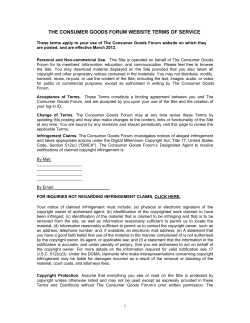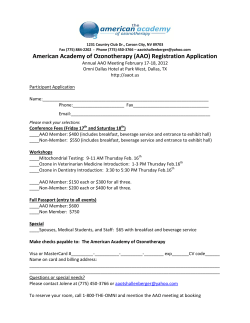
Federal Institute for Risk Assessment (BfR)
Federal Institute for Risk Assessment (BfR) Tasks • Risk Assessment • Recommendations on risk reduction • Scientific advice to the relevant federal ministries and other instituitions • Research on topics which are closely related to the assessment tasks • Communication The BfR is independent in its scientific evaluations, research and communication. Dr. Suzan Fiack, 16th of January 2014, Humboldt Forum for Food and Agriculture, Berlin Page 2 Federal Institute for Risk Assessment (BfR) - History Kaiserliches Gesundheitsamt (1876-1919) Reichsgesundheitsamt (1919-45) Federal Ministry for Youth, Family Affairs and Health (1952-1994) Federal Institute for Health Protection of Consumers and Veterinary Medicine (1994-2002) Risk Management Risk Assessment 6. August 2002 Dr. Suzan Fiack, 16th of January 2014, Humboldt Forum for Food and Agriculture, Berlin Page 3 Science and Uncertainty “More research brings more ignorance to the light of day” (Douglas/Wildavsky) Scientific knowledge: • produces no absolute truths • is not static • is based on more or less well-founded assumptions, scenarios and probabilities • is also a source of uncertainty Dealing with uncertainty is important in the communication of scientific knowledge. Dr. Suzan Fiack, 16th of January 2014, Humboldt Forum for Food and Agriculture, Berlin Page 4 Examples: Dioxin, EHEC, Glyphosat Increased dioxin concentrations in eggs and meat - 2011 • Industrial fatty acids with high dioxin concentrations • Illegal action • High media attention, No health risk was expected 1 EHEC Outbreak - 2011 2 • Biggest bacterial outbreak of Escherichia coli in Germany since the Second World War with more than 50 deaths • Very unusual EHEC strain O104:H4 Glyphosat – Reassessment 2013/2014 3 • One of the most widely used active ingredients in herbicides worldwide Dr. Suzan Fiack, 16th of January 2014, Humboldt Forum for Food and Agriculture, Berlin Page 5 Challenges in Risk Communication: Dioxin 2011 7. Januar 2011 Dioxin levels exceed the legal standard by 77-fold. Dr. Suzan Fiack, 16th of January 2014, Humboldt Forum for Food and Agriculture, Berlin Page 6 Challenges in Risk Communication: Health Based Guidance Values and Maximum Level Dioxin 2011: What does this mean for the health of consumers? TDI: 2 pg/kg KG/Day „Levels 77 times higher than limit“ Maximum Level 3,0 pg/ g Fett Egg Fat Feed Human Maximum result 4times higher than maximum level Animal n (measurements) 175 Mean 1,9 Min 0,1 Max 12,1 %>ML 19 Dr. Suzan Fiack, 16th of January 2014, Humboldt Forum for Food and Agriculture, Berlin High consumption of eggs (mean value): 10 % of the TDI (12,6% children) Page 7 For Particularly Concerned Consumers: Worst Case instead of Mean Value Average dioxin body burden of young adults pg/g fat 20 15 10 5 30 pg/ g body fat 25 today 10 pg/g body fat 30 20 years ago Consumption of 2 eggs/d for 1 month Consumption of 2 eggs/d for 1 year pg/g fat 30 30 25 25 20 20 15 15 10 10 5 5 0 0 dioxin ML: 3 pg/g egg (fat) 4-fold exceedance dioxin ML: 12 pg/g egg (fat) dioxin ML: 3 pg/g egg (fat) 4-fold exceedance dioxin ML: 12 pg/g egg (fat) 0 Body burden today (10 pg/g body fat) Dr. Suzan Fiack, 16th of January 2014, Humboldt Forum for Food and Agriculture, Berlin Increase of body burden Page 8 Challenges in Risk Communication: Understanding uncertainty / lack of knowledge • Uncertainty Not much data at the beginning (duration of dioxin analysis) • Lack of Knowledge Understanding of maximum levels: Even though foods are not tradable, no adverse health impacts are to be expected • Risk Perception Dioxin = “ultra toxin” 5. January 2011 "An acute health risk does not exist," said a spokesman of the Federal Institute for Risk Assessment (BfR). He relied on the results of a study in which FOUR EGGS showed incresed dioxin levels. Dr. Suzan Fiack, 16th of January 2014, Humboldt Forum for Food and Agriculture, Berlin Page 9 Press conference at the „Green Week“ 2011: Consumers do not have to worry Even if eggs or pork meat with contents in the range of the highest measured values were consumed over a longer period of time during the past months, no health risk is to be expected. The intake of dioxins through foods must be minimised as far as possible. The exceeding of the legal maximum level in food and feed is not acceptable. Dr. Suzan Fiack, 16th of January 2014, Humboldt Forum for Food and Agriculture, Berlin Page 10 The fight against “poison” Risk perception factor: Accident history Foto: dpa Seveso • Chemical accident in 1976 north of Milan • 2,3,7,8-tetrachlorodibenzodioxin (“dioxin”) released into the environment Agent Orange • Herbicide, used as a defoliant in the Vietnam War (1962 – 1971) • Contamination with 2,3,7,8-tetrachlorodibenzodioxin (“dioxin”) • Several hundred thousands of inhabitants and US soldiers affected Yushchenko • Assassination attempt in late 2004: the former President of Ukraine Yushchenko was confirmed to have ingested hazardous amounts of „dioxin“ Dr. Suzan Fiack, 16th of January 2014, Humboldt Forum for Food and Agriculture, Berlin Page 11 2010 Eurobarometer survey report on risk perception in the EU Could you tell me in your own words, what are all the things that come to your mind when thinking about possible problems or risks associated with food and eating? The survey was carried out on a representative sample of 26,691 individuals, aged 15 or over in all 27 Member States. Dr. Suzan Fiack, 16th of January 2014, Humboldt Forum for Food and Agriculture, Berlin Page 12 Risk Perception Factors: Dioxin Incident 2011 Extent Eggs and meat were affected by the dioxin incident in 2011. With the exception of vegans, many consumers have regular contact with these staple foods. Voluntariness Consumers are involuntarily exposed to the risk of “dioxin in food”. Personal Control Consumers have hardly any personal control over the risks – the dioxin concentration of an egg is not visible. Immediacy The effects of increased dioxin contamination are long-term rather than immediate. Severity of consequences The long-term effects of increased dioxin levels include disturbances of the central nervous system and hormone balance. It is assumed that some dioxins can increase the risk of contracting cancer. Dr. Suzan Fiack, 16th of January 2014, Humboldt Forum for Food and Agriculture, Berlin Page 13 Overview EHEC May to July 2011: a real crisis in consumer protection EHEC Outbreak 2 • Biggest bacterial outbreak of Escherichia coli in Germany since the Second World War with more than 50 deaths • Very unusual EHEC strain O104:H4 • May 2011: Increase in the number HUS cases • Preliminary results of epidemiological studies (Robert Koch-Institute, RKI): Recommendation (BfR and RKI) on 25 May 2011, by way of precaution, not to consume raw tomatoes, cucumber and leaf lettuce Dr. Suzan Fiack, 16th of January 2014, Humboldt Forum for Food and Agriculture, Berlin Page 14 Overview EHEC May to July 2011: a real crisis in consumer protection • Combined forward/backward trade relations tracking strategy • Evaluation of company supply channels: carriers of the EHEC bacteria were with high probability sprouts from a farm in Germany, New epidemiological data • Recommendation to consumers on 10 June 2011 not to eat any raw sprouts • At the end of June 2011, a cluster of EHEC O104:H4 cases in France was also traced back to the consumption of sprouts • Connection between the German and French cases: a batch of fenugreek seeds produced in Egypt • High probability that fenugreek seeds used for sprout production were the cause • European Commission: Recall and destruction of certain fenugreek seed batches from Egypt, import ban on certain seeds and other plant-based foods from Egypt for a limited period Dr. Suzan Fiack, 16th of January 2014, Humboldt Forum for Food and Agriculture, Berlin Page 15 Challenges in Risk Communication: Uncertainty May 2011: Epidemiological study carried out by the Robert Koch Institute (RKI) together with the Hamburg health authorities Affected patients had eaten raw tomatoes, cucumber and leaf lettuce significantly more often than healthy study participants. - All pointed from an early stage to food contaminated with EHEC as the source of infection - Based on the results of this early survey (Robert Koch-Institut), vehicles such as raw milk, raw meat, sprouts and shoots did not appear to play a role. Can public institutions delay talking about risks until the data situation is “certain”? What risks are involved in waiting longer? Dr. Suzan Fiack, 16th of January 2014, Humboldt Forum for Food and Agriculture, Berlin Page 16 Challenges in Risk Communication: Uncertainty Preliminary results of the EHEC/HUS study Joint Statement No. 014/2011 of the BfR and RKI of 25 May 2011 RKI and BfR recommend, by way of precaution, not to consume raw tomatoes, cucumbers and leaf lettuce, more particularly in Northern Germany, until further notice. It cannot be excluded that other foods play a role as an infection source, too. Dr. Suzan Fiack, 16th of January 2014, Humboldt Forum for Food and Agriculture, Berlin Page 17 Challenges in Risk Communication: Uncertainty 26. May 2011 Hamburger Institut für Hygiene und Umwelt O104 ? O104 Detection of EHEC in cucumbers in Hamburg 66 HUS-Cases in Hamburg - Suspicion of O104 confirmed The detection of EHEC in cucumbers in Hamburg, which were, amongst others, imported from Spain, resulted in several warnings through the European Rapid Alert System. It has not yet been proven that the EHEC subtype on the analysed cucumbers is the same as in the stool specimen of the patients. Dr. Suzan Fiack, 16th of January 2014, Humboldt Forum for Food and Agriculture, Berlin Page 18 Media Spanish Cucumbers are the EHEC Carrier EHEC: Spanish cucumbers are to blame Dr. Suzan Fiack, 16th of January 2014, Humboldt Forum for Food and Agriculture, Berlin Page 19 Challenges in Risk Communication: Variety of Expert Opinions Until then, the very unlikely but theoretically conceivable worst case that the bacteria were released intentionally cannot be excluded either. (Mikrobiologist in the journal Tagesspiegel, 25th May 2011) It is perfectly adequate to wash vegetables thoroughly. (Expert in the field of hygiene in the journal The European, 9th June 2011) Never before have such dangerous intestinal germs been found on fruit and vegetables. If beef were the source of the dangerous germ, it could have something to do with the massive addition of antibiotics to animal feed. (A WHO Expert in the journal La Repubblica, 4th June 2011) Translation: BfR Dr. Suzan Fiack, 16th of January 2014, Humboldt Forum for Food and Agriculture, Berlin Page 20 Understanding Uncertainty E. Coli source still vague. Authorities are “struggling” in their efforts to find the source (Deutsches Ärzteblatt , 4. June 2011) (foodsafetynews, 9.June 2011) No guarantee for clarification 5. June ZDF – German Television BfR President Professor Dr. Dr. Andreas Hensel In most cases outbreak investigations do not deliver results. Translation: BfR Dr. Suzan Fiack, 16th of January 2014, Humboldt Forum for Food and Agriculture, Berlin Page 21 Example EHEC press conference 10th of June: 'It's the sprouts.' As a precaution in addition to the standard hygiene measures, BfR, BVL and RKI recommend that sprouts should not be eaten raw until further notice. Dr. Suzan Fiack, 16th of January 2014, Humboldt Forum for Food and Agriculture, Berlin EHEC 2011: 10 Press releases 11 Opinions ~ 50 FAQ > 300 Media requests 50 TV Interviews 5 Press conferences > 500 requests from the public Page 22 Behavioural changes due to EHEC during the outbreak Did you change your habits during the EHEC outbreak in order to protect yourself from the bacteria? What did you do to protect yourself? No Yes 49 % 51 % Did not eat certain foods Did not eat raw fruit, vegetables or sprouts Did not eat fruit, vegetables or sprouts in restaurants/snack bars/canteen/cafeteria Washed some foods more thoroughly 72 % 59 % 52 % 51 % Washed hands more often 49 % Changed shopping habits 48 % Peeled fruit and vegetables more often 39 % Ensured more kitchen hygiene Washed certain foods at higher water temperatures Roughly half of those questioned changed their habits during the outbreak. 39 % 33 % Cooked my own food 2% Bought organic produce 1% Don’t know/no answer/none of the above 1% Dr. Suzan Fiack, 16th of January 2014, Humboldt Forum for Food and Agriculture, Berlin Page 23 Comprehension of Consumption Recommendations Did you understand why the initial recommendation not to eat green salad, tomatoes and cucumber was repealed in the light of new information? No 23 % Don‘t know/ no answer 3% Yes 74 % The reversal of the consumption recommendation was understood by 74 % of those questioned. n = 931; information in percent Dr. Suzan Fiack, 16th of January 2014, Humboldt Forum for Food and Agriculture, Berlin Page 24 Assessment of State Measures Have the responsible authorities in Germany done enough to protect the general public from the EHEC pathogen in your opinion? No 21 % Don‘t know/ no answer The vast majority of those questioned stated that the responsible bodies have done enough to protect the general public from the ja pathogen. EHEC 8% 71 % Yes n = 931; information in percent Dr. Suzan Fiack, 16th of January 2014, Humboldt Forum for Food and Agriculture, Berlin Page 25 Comparative Risk Estimation: EHEC vs. Dioxin How would you estimate your own personal risk of damaging your health when comparing the two incidents, dioxin in foodstuffs and EHEC? Dioxin risk is much higher 14 % 16 % Dioxin risk is slightly higher 40 % Both risks are equally high EHEC risk is slightly higher EHEC risk is much higher Don't know/ no answer 14 % 8% 8% n = 803; interviewees who had heard or read about dioxin; information in percent Dr. Suzan Fiack, 16th of January 2014, Humboldt Forum for Food and Agriculture, Berlin Page 26 Examples 2013 Glyphosate 3 • is one of the most widely used active ingredients in herbicides worldwide. • is currently subject to a comprehensive re-evaluation process by the European Union (EU). Re-assessment is a routine procedure controlled by the European Commission. Germany acts as Rapporteur Member State (RMS) writing a draft re-assessment report. Several competent authorities in Germany are involved in the writing process (i.e., the Federal Institute for Risk Assessment, BfR). After the establishment of a draft re-assessment report this report will be send to the European Food Safety Authority (EFSA). Dr. Suzan Fiack, 16th of January 2014, Humboldt Forum for Food and Agriculture, Berlin Page 27 Perception of Pesticide Residues in Germany Pesticide residues in fruit, vegetables or cereals”: Geographical distribution of “Total worried” 75% of Germans are worried about pesticide residues in fruit, vegetables or cereals 78% associate the term ‚toxic‘ with food produced with pesticides 67% think that pesticide residues in food are illegal Sources: Eurobarometer 2010, BfR 2009 Dr. Suzan Fiack, 16th of January 2014, Humboldt Forum for Food and Agriculture, Berlin Page 28 Media report on glyphosate - Example ZDFzoom investigates the active ingredient in detail: Deformities in newborn babies and cancer are, again and again, associated with the substance in scientific studies. In addition: The substance has long since arrived in our food chain, meaning that it is in our bodies. The latest as yet unpublished studies show: 60 to 70 per cent of the population have glyphosate in their body. ZDF Zoom 08/05/2013 Translation: BfR Dr. Suzan Fiack, 16th of January 2014, Humboldt Forum for Food and Agriculture, Berlin Page 29 Parliamentary question asked by Members of Parliament Harald Ebner, Uwe Kekeritz, Cornelia Behm, additional Member of Parliament and the parliamentary group BÜNDNIS 90 / DIE GRÜNEN on glyphosate, June 2013 What information does the Federal Government have regarding the extent and causes of what by now appears to be the ubiquitous contamination of the German population with glyphosate and its metabolites which was also mentioned in the coverage of the subject of ZDF Magazin “ZOOM” broadcast on 8 May 2013, and what conclusions does the Federal Government draw from this information? Translation: BfR Dr. Suzan Fiack, 16th of January 2014, Humboldt Forum for Food and Agriculture, Berlin Page 30 Response of the BfR and the Federal Government BfR Opinion No. 014/2013 of 14 June 2013 The BUND study results are plausible and indicate a background contamination of glyphosate; however this is far below a level that poses a potential health risk. Response of the Federal Government No representative data on the contamination of the German population from glyphosate … are available to the Federal Government. The recently published “BUND study” “ …” contains indications that general background exposure to glyphosate is present among European citizens. However, in the opinion of the BfR, this is far below levels that could pose a risk to human health. Translation: BfR Dr. Suzan Fiack, 16th of January 2014, Humboldt Forum for Food and Agriculture, Berlin Page 31 The BfR has finalised its draft report for the re-evaluation of glyphosate > 150 new toxicological studies were evaluated for the first time ~ 300 available toxicological studies were re-assessed ~ 900 publications from scientific journals have been considered The available data do not show carcinogenic or mutagenic properties of glyphosate nor that glyphosate is toxic to fertility, reproduction or embryonal/fetal development in laboratory animals. There is convincing evidence that the measured toxicity of some glyphosate containing herbicides is the result of the co-formulants in the plant protection products (e.g., tallowamines used as surfactants). Translation: BfR Dr. Suzan Fiack, 16th of January 2014, Humboldt Forum for Food and Agriculture, Berlin Page 32 Criticism Glyphosate kills. (www.bund.net; accessed December 2013) Risk of wangling between business and authorities. (Friends of the Earth, Germany, 24/09/2013) Glyphosate and glyphosate-containing products are by no means harmless substances for controlling weeds. (http://www.schule-und-gentechnik.de/lehrer/fallbeispiele/glyphosat.html, Information Service for Genetic Engineering, accessed December 2013) Translation: BfR Dr. Suzan Fiack, 16th of January 2014, Humboldt Forum for Food and Agriculture, Berlin Translation: BfR Page 33 BfR continues its active investigation To support public debate on the risk assessment of glyphosate, the BfR will held a scientific symposium on 20th January 2014 about the Safety of plant protection products containing glyphosate at ICC Berlin, Germany during Green Week Dr. Suzan Fiack, 16th of January 2014, Humboldt Forum for Food and Agriculture, Berlin Page 34 Challenges in Risk Communication: Understanding uncertainty Uncertainty can occur in many different ways: Not enough data, lack of knowledge, different expert opinions, uncertainty regarding the risk level, exposure etc. Making uncertainty a subject of discussion is often not understood. It sometimes strengthens trust in the information source, but it is also regarded at times as a sign of incompetence and dishonesty. The cause of uncertainty is not seen in the nature of the matter itself but mostly in social factors. A simple appraisal (Is it safe?) is often preferred to the statement of uncertainties. Dr. Suzan Fiack, 16th of January 2014, Humboldt Forum for Food and Agriculture, Berlin Page 35 Challenges in Risk Communication: Dealing with uncertainty 1. Don’t wait to be confronted. Acknowledge uncertainty up-front. 2. Put bounds on uncertainty. What range of possibilities is credible? 3. Clarify that you are more certain about some things than others. 4. Explain what you have done or are doing to reduce the uncertainty. 5. If the remaining uncertainty is very small or very difficult to reduce further, say so. Don’t overpromise. Dealing with Uncertainty Copyright © 1993 by Peter M. Sandman …. Dr. Suzan Fiack, 16th of January 2014, Humboldt Forum for Food and Agriculture, Berlin Page 36 Risks at a glance: the BfR risk profile new from 19 April 2013 ! BfR risk profile on … A Probability B C of health impairment Severity of health impairment Validity of D available data E Group of persons Affected group Controllability by the consumer Practically impossible Improbable No impairment Possible Slight impairment Probable Moderate impairment Certain Serious impairment [reversible / irreversible] High: the most important data is available and there are no contradictions Control not necessary Medium: some important data is missing or contradictory Controllable through precautionary measures Dr. Suzan Fiack, 16th of January 2014, Humboldt Forum for Food and Agriculture, Berlin Low: much important data is missing or contradictory Controllable through avoidance Not controllable Page 37 New Formats Videos based on questions from consumers Mobile Website / Apps Twitter Dr. Suzan Fiack, 16th of January 2014, Humboldt Forum for Food and Agriculture, Berlin Page 38 What is certainty? Absolute certainty cannot be achieved. Dr. Suzan Fiack, 16th of January 2014, Humboldt Forum for Food and Agriculture, Berlin Page 39 Thank you Walter Pechmann Gesellschaft für Konsumforschung GfK, Nürnberg Regine Rehaag Gabriele Tils Katalyse, Institut für angewandte Umweltforschung, Köln Carl Vierboom, Ingo Härlen Wirtschafts- und Kommunikationspsychologie, Bonn Mario Hopp Kommunikationsforschung, Berlin Gaby-Fleur Böl Astrid Epp Klaus Jürgen Henning Anne-Katrin Hermann Stephanie Kurzenhäuser-Carstens Mark Lohmann Unit Press and Public Relations Abteilung Risikokommunikation Bundesinstitut für Risikobewertung Oliver Pfirrmann prognos AG, Berlin Ortwin Renn Dialogik gGmbH, Stuttgart Christopher Coenen Inst. f. Technikfolgenabschätzung u. Systemanalyse, Forschungszentrum Karlsruhe Dirk Scheer, Ulrich Petschow, Gerd Scholl Inst. f. ökologische Wirtschaftsforschung, Berlin Dr. Suzan Fiack, 16th of January 2014, Humboldt Forum for Food and Agriculture, Berlin Page 40 FEDERAL INSTITUTE FOR RISK ASSESSMENT Thank you for your attention Suzan Fiack Federal Institute for Risk Assessment Max-Dohrn-Str. 8-10 10589 Berlin, GERMANY Tel. +49 30 - 184 12 - 0 Fax +49 30 - 184 12 - 47 41 bfr@bfr.bund.de www.bfr.bund.de
© Copyright 2025











